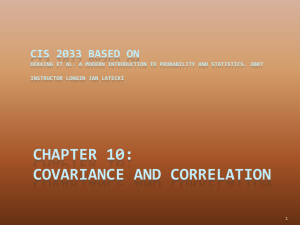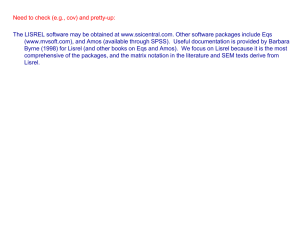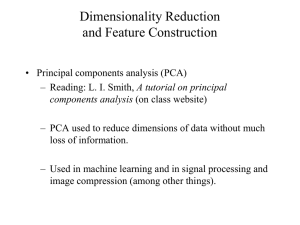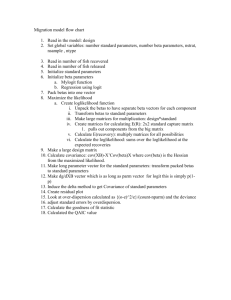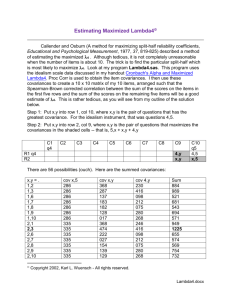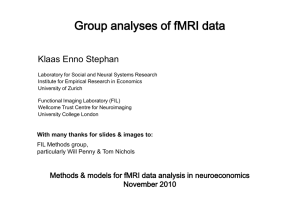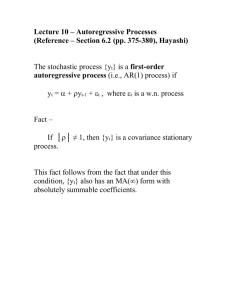Covarince Stationary Time Series
advertisement
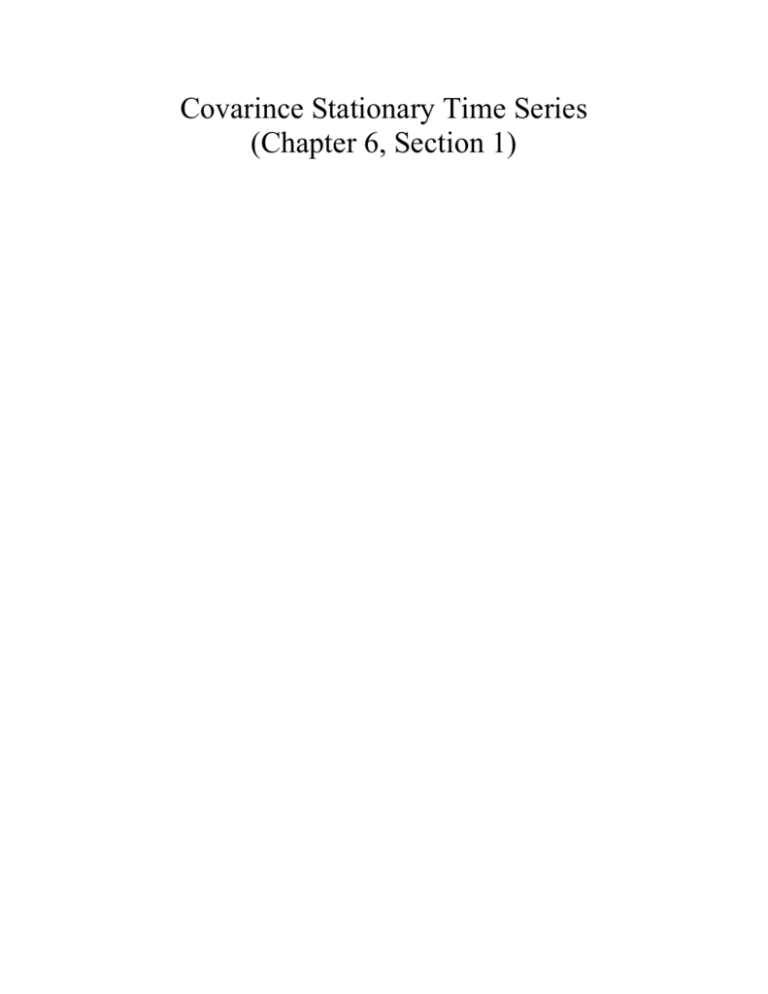
Covarince Stationary Time Series
(Chapter 6, Section 1)
The cyclical component of a time series is,
in contrast to our assumptions about the
trend and seasonal components, a
“stochastic” (vs. “deterministic”) process.
That is, its time path is, to some extent,
fundamentally unpredictable.
Our model of that component must take this
into account.
We will assume that the cyclical component
of a time series can be modeled as a
covariance stationary time series.
What does that mean?
Consider our data sample, y1,…,yT
We imagine that these observed y’s are the
outcomes of drawings of random variables.
In fact, we imagine that this data sample or
sample path, is just part of a sequence of
drawings of random variables that goes back
infinitely far into the past and infinitely far
forward into the future.
In other words, “nature” has drawn values of
yt for t = 0, + 1, +2,… :
{…,y-2,y-1,y0,y1,y2,…}
This entire set of drawings is called a
realization of the time series. The data we
observe, {y1,…,yT} is part of a realization of
the time series.
(This is a model. It is not supposed to be
interpreted literally!)
We want to describe the underlying
probabilistic structure that generated this
realization and, more important, the
probabilistic structure that governs that part
of the realization that extends beyond the
end of the sample period (since that is part
of the realization that we want to forecast).
Ideally, there are key elements of this
probability structure that remain fixed over
time. This is what will enable us to use the
sample path to use inferences drawn about
the proababilistic structure that generated
the sample to draw inferences about the
probabilistic structure that will generate
future values of the series.
For example, suppose the time series is a
sequence of 0’s and 1’s corresponding to the
outcomes of a sequence of coin tosses, with H =
0 and T = 1: {…0,0,1,0,1,1,1,0,…}
What is the probability that at time T+1 the
value of the series will be equal to 0?
If the same coin is being tossed for every t, then
the probability of tossing an H at time T+1 is the
same as the probability of tossing an H at times
1,2,…,T. What is that probability? A good
estimate would be the number of H’s observed
at times 1,…,T divided by T. (By assuming that
future probabilities are the same as past
probabilities we are able to use the sample
information to draw inferences about those
probabilities.)
Suppose however that a different coin will be
tossed at T+1 than the one that was tossed in the
past. Then, our data sample will be of no help in
estimating the probability of an H at T+1. All we
can do is make a blind guess!
Covariance stationarity refers to a set of
restrictions/conditions on the underlying
probability structure of a time series that has
proven to be very especially valuable in this
regard.
A time series, yt, is said to be covariance
stationary if it meets the following
conditions –
1. Constant mean
2. Constant (and finite) variance
3. Stable autocovariance function
1. Constant mean
Eyt = μ
{vs. μt}
for all t. That is, for each t, yt is drawn from
a population with the same mean.
Consider, for example, a sequence of coin
tosses and set yt = 0 if H at t and yt = 1 if T
at t. If Prob(T)=p for all t, then Eyt = p for
all t.
Consider, for example, the HEPI time series.
Does that time series look like a
time series whose values have been
drawn from a population with a
constant mean?
What about the deviations from
trend?
What about the growth rate?
What about your detrended series?
Caution – the conditions that define
covariance stationarity refer to the
underlying probability distribution that
generated the data sample rather than to the
sample itself. However, the best we can do
to assess whether these conditions hold is to
look at the sample and consider the
plausibility that this sample was drawn from
a stationary time series.
2. Constant Variance
Var(yt) = E[(yt- μ)2] = σ2 {vs. σ2t} for all t.
The dispersion of the value of yt around its
mean is constant over time.A sample in
which the dispersion of the data around the
sample mean seems to be increasing or
decreasing over time is not likely to have
been drawn from a time series with a
constant variance.
Consider, for example, a sequence of coin
tosses and set yt = 0 if H at t and yt = 1 if T
at t. If Prob(T)=p for all t, then
Eyt = p
and
Var(yt) = E[(yt – p)2] = p(1-p)2+(1-p)p2
for all t.
Detrended HEPI? HEPI growth rate? Your
detrended series?
Digression on covariance and correlation
Recall that
Cov(X,Y) = E[(X-EX)(Y-EY)]
and
Corr(X,Y) = Cov(X,Y)/[Var(X)Var(Y)]1/2
measure the relationship between the random
variables X and Y.
A positive covariance means that when
X > EX, Y will tend to be greater than EY (and
vice versa). A negative covariance means that
when X > EX, Y will tend to be less than EY
(and vice versa).
The correlation between X and Y will have the
same sign as the covariance but its value will lie
between -1 and 1. The stronger the relationship
between X and Y, the closer their correlation
will be to 1 (or, in the case of negative
correlation, -1).
If the correlation is 1, X and Y are perfectly
positively correlated. If the correlation is -1, X
and Y are perfectly negatively correlated. X and
Y are uncorrelated if the correlation is 0.
Independent random variables are uncorrelated.
Uncorrelated random variables are not
necessarily independent.
End Digression
3. Stable autocovariance function
The autocovariance function of a time
series refers to covariances of the form:
Cov(yt,ys) = E[(yt - Eyt)( ys – Eys)]
i.e., the covariance between the drawings of
yt and ys.
Note that
Cov(yt,yt) = Var(yt)
Cov(yt,ys) = Cov(ys,yt)
For instance,
Cov(yt,yt-1)
measures the relationship between yt and
yt-1.
Your textbook refers to this as the
autocovariance at displacement 1.
We expect that Cov(yt,yt-1) > 0 for most
economic time series: if an economic time
series is greater than normal in one period it
is likely to be above normal in the
subsequent period – economic time series
tend to display positive first order
correlation.
In the coin toss example (yt = 0 if H, yt = 1 if
T), what is Cov(yt,yt-1)?
What about the sign of Cov(yt,yt-1) for the
detrended HEPI?
Suppose that
Cov(yt,yt-1) = γ(1) for all t
where γ(1) is some constant.
That is, the autocovariance at displacement
1 is the same for all t:
…Cov(y2,y1)=Cov(y3,y2)=…=Cov(yT,yT-1)=…
In this special case, we might also say that
the autocovariance at displacement 1 is
stable over time.
For example, in the coin toss example,
Cov(yt,yt-1) = γ(1) = 0 for all t
The third condition for covariance
stationarity is that the autocovariance
function is stable at all displacements.
That is –
Cov(yt,yt-τ) = γ(τ) for all integers t and τ
The covariance between yt and ys depends
only t and s only through t-s (how far apart
they are in time) not on t and s themselves
(where they are in time).
Cov(y1,y3)=Cov(y2,y4) =…=Cov(yT-2,yT) = γ(2)
and so on.
It is hard to make this condition intuitive.
The best that I can offer – If we break the
entire time series up into different segments,
the general behavior of the series looks
roughly the same for each segment.
Notes –
stability of the autocovariance function
(condition 3) actually implies a constant
variance (condition 2); set τ = 0.
γ(τ) = γ(-τ) since
γ(τ) = Cov(yt,yt-τ) = Cov(yt- τ,yt) = γ(-τ)
If yt is an i.i.d. sequence of random
variables then it is a covariance
stationary time series.
{The “identical distribution” means that
the mean and variance are the same for
all t. The independence assumption
means that γ(τ) = 0 for all nonzero τ,
which implies a stable autocovariance
function.}
The conditions for covariance stationary are
the main conditions we will need regarding
the stability of the probability structure
generating the time series in order to be able
to use the past to help us predict the future.
It is important to note that these conditions
do not
imply that the y’s are identically
distributed (or, independent).
place restrictions on third, fourth, and
higher order moments (skewness,
kurtosis,…). [Covariance stationarity
only restricts the first two moments and
so it also referred to as “second-order
stationarity.”]
